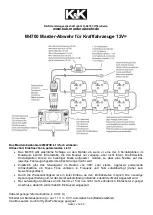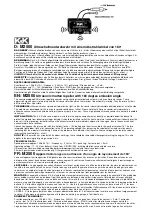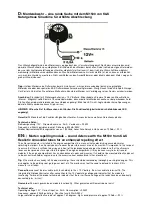
Note: Always cut off power when connecting the device's circuits.
4.3 Use shielded copper cables (wire cross-section from 0.14 to 1.5 mm2) with
insulating jacket when mounting the device.
4.4 We recommend using a circular cross-section wire to make the cable
gland seal reliable; suggested outside diameters:
- for M16x1.5 -
cable Ø6 ... 10 mm (power supply and output signal);
- for M20x1.5 - cable Ø7 ... 12.5 mm (switching lines).
Sealing cable gland with standard rings and gaskets is MANDATORY.
1
2
3
4
5
DO NOT:
allow voltage exceeding maximum specified for the
transmitter;
use any objects to touch or otherwise apply mechanical
force to the diaphragm;
use transmitters bearing visible signs of mechanical
damage;
use transmitters in inappropriate climatic conditions;
allow medium temperatures above or below the limits
specified for the transmitter.
5 Setup
5.1 There is a display and four buttons on the front panel of the device. See
Figure 2 for their description.
Figure 2 - Elements on the front panel of the device
5.2 Buttons allow changing the device's parameters when it is in use. For
example, you can select units the measured pressure is displayed in, set
switch thresholds, change span within the basic measurement range, adjust
(calibrate) measurement results. See Setup instructions for procedures.
5.3 When switched on, the device self-tests. If everything is in working order,
its output current and voltage signals are set linearly matching the measured
pressure.
5.4 Malfunctions (related to data or system) are detected by the integrated
controller. Detection of a system malfunction (at startup or during operation)
results in outputting constant current (see Table 2).
6 Maintenance
Routine maintenance frequency -
at least once a year; it includes checking
reliability of mounting and removal of dust and dirt. Do not use chemical
solvents and forced rinsing for cleaning purposes.
Routine checkups of the device in use follow data specified in its passport.
See the device's passport for its calibration interval and manufacturer's
warranty.
Manufacturer refuses all claims, reclamations, complaints related to devices
with damaged manufacturer seals and showing signs of damage resulting
from inappropriate operation, transportation or storage.
All and any repairs are done by the manufacturer exclusively.
7 Marking
The device bears a label (sticker on the back of the housing) that contains the
following information (Figure 3):
1) name of the manufacturer;
2)
code of the device;
3) bar code (QR code);
4)
output signals ranges;
5) supply voltage and its
type;
6) serial number and production date;
7)
manufacturer's trademark;
8) electrical protection class (GOST 12.2.007.0);
9) ingress protection rate (GOST 14254);
10) measured pressure range.
Figure 3 - Device label
8 Package contents
See Table 4 for delivery package contents.
Table 4 - Package contents
Name
Quantity
APZ 2030 differential pressure transmitter
1 pc
Passport
1 copy
User manual (this paper)
1 copy*
Setup Manual
1 copy*
* 1 copy per 10 devices for batch supplies to the same address.
9 Transportation and storage
9.1 Use roofed transport to deliver the device to any destination needed; place
individual packages into shipping containers if required.
9.2 Make sure the devices are protected from impacts and vibrations while in
transit; permissible temperature for products transported in shipping
containers ranges from -10 to +50 °C.
9.3
Store devices in shipping containers in a heated (+5 to 40 °С) ventilated
space.
10 Resource and service life
10.1 Operating mode: continuous.
10.2 Mean time between failures, min – 120,000 h.
10.3 Service life - 12 years (normal working conditions: non-aggressive
medium, temperature at +23 ± 3 °С, no vibrations and shaking).
11 Disposal
11.1 The device contains no precious metals.
11.2 Dispose of as prescribed by regulations adopted by the operator.
Supplement A
Design and dimensions
Figure A.1 - Housing and mounting holes
------------------------------------------------------------------------------------------
© Piezus
http://www.piezus.ru/
Made in Russia






















